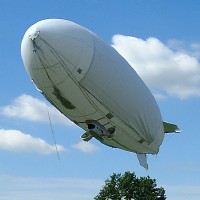The objectives of this project are:
- Develop a means of performing extended term environmental monitoring with an autonomous aerial vehicle.
- Investigate motion planning and control for the aerial vehicle that utilizes the elements such as prevailing air currents to extend its range and achieve desired trajectories.
- Investigate methods of performing intelligent sampling using onboard autonomy to select and follow targets intelligently.
The project is a collaborative effort with Professor Jim Ostrowski of the University of Pennsylvania Department of Mechanical Engineering and the STWing-SEAS research team. To date, work towards our objectives has progressed in four main areas:
- development and construction of a 30 ft. airship,
- dynamics modeling of the airship for MATLAB simulations,
- investigation of control and path planning algorithms for the airship, and
- study of the use of solar energy to power the airship.
Details of these activities are listed below.
Solar Power for Airships: In our study of the application and applicability of solar power for airships we have proceeded to both from theory to analyze possible energy attainable as well as from practice to examine the current efficiency of such systems. We have conducted a number of simulation studies analyzing solar flux with varying latitude/longitude, date, and atmospheric conditions. We have employed accepted environmental models for estimating radiative transfer and employed the SBDART package for comparative simulations. Unlike typical solar power applications we have been considering power collection at altitude and the significance of panel pointing during flight; there is an crucial optimization between orienting for navigation and orienting for highest solar flux. We have also completed a study of current solar cell technology and efficiencies, but to determine the feasibility of solar-powered operation a system view is necessary. So, we have examined the efficiency of energy storage systems, specifically power-point tracking battery chargers, battery technologies, and power distribution equipment. We are now beginning component testing with a prototype solar power system and intend by August 2002 to have a complete analysis of the feasibility of solar-power for long-duration airship operation.
Airship Construction: Construction of a 30ft blimp with semi- and fully-autonomous capabilities. Initial flight tests are underway, and the computer system is partially operational. Onboard equipment includes gyros, altimeter, color camera, GPS, and wireless ethernet. This project was undertaken as a research project conducted by a team of undergraduate students at the University of Pennsylvania.
Airship Modeling: A full six-degree of freedom model of the airship has been developed from first principles and implemented in MATLAB simulations. The parameters of this model have been adjusted in an ad hoc manner so that the model response mimics that of the actual airship (efforts in the near future will take a more formal approach to system identification for the airship). The most important modification has been to incorporate the effect of lift surfaces (tail rudder and elevators), and the unidirectional thrusters (previous models allowed for bi-directional thrust using electric motors).
Airship Planning and Control: A number of techniques for path planning and control of the airship have been developed and demonstrated in simulation. Feedback controllers that cause the airship to stably follow geographical features in the presence of disturbances have been investigated. Specifically, a dynamic extension to the wellknown “pure pursuit” algorithm allows the underactuated airship to employ oversteering in order to track features in the presence of an unknown, constant wind field. Previously developed control algorithms that assumed bidirectional thrusters and ignored lift surfaces are being modified to incorporate these changes. The unidirectional thrust presents significant challenges, and it is clear that station-keeping as previously performed with an indoor blimp will not be feasible. Study of randomized techniques, in particular the randomized trees (RRTs), for fast motion planning under numerically modeled environmental forces, such as wind patterns, etc. These techniques have been successfully applied in simulation to develop feasible paths that solve the motion planning problem while minimizing energy usage.



